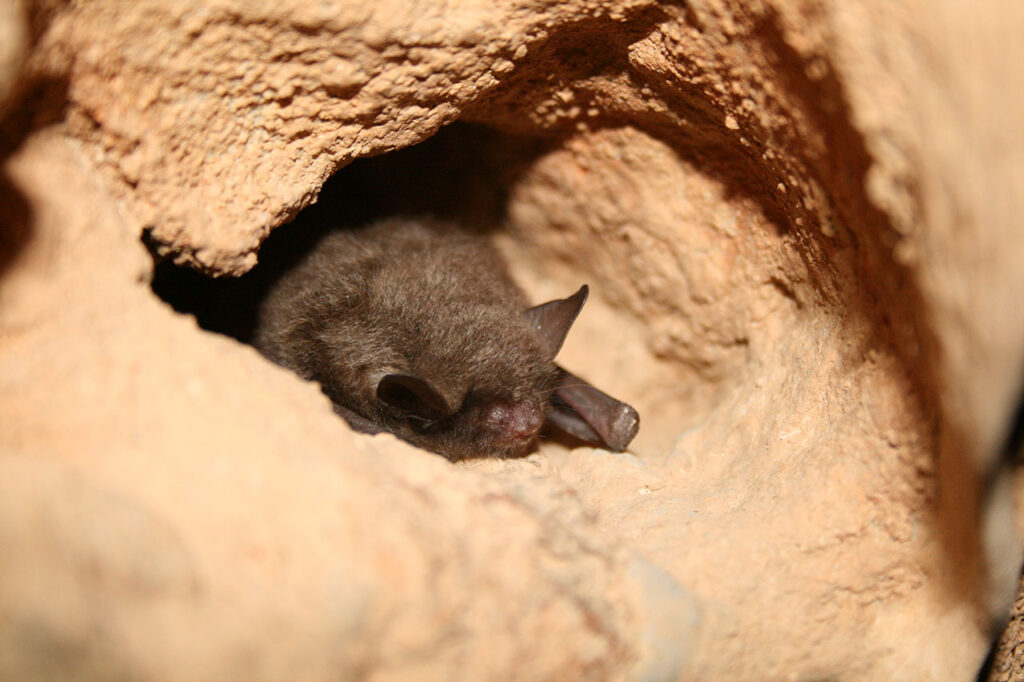Indiana Bat Facts
Also known as the Northern long-eared bat and the social bat, the Indiana bat is found throughout the Eastern United States and Canada. It spends its summer roosting in trees. At night, the Indiana bat hunts for insects such as moths, mosquitoes, beetles, and flies. Like most other species of bats, Indiana bats use echolocation to navigate and locate prey in the dark.

These medium-sized, mouse-eared bats tend to roost in colonies, hence why one of its nicknames is the social bat. During the winter, the Indiana bat hibernates in caves and mines. Such habitats are known as a bat’s “hibernacula”. In some cases, Indiana bats will roost or hibernate in man-made structures or homes.
Types of Indiana Bats
Indiana Bat Identification
The Indiana bat ranges in size from two to four inches in length, with a wingspan of nine to 11 inches. Its fur is typically dark gray or brown. Due to the similarities in coloring, it’s difficult to differentiate an Indiana bat from the common brown bat unless it’s examined closely. Distinguishing features of the Indiana bat include the size of their feet, length of the toe hairs, and their pink lips.
Indiana Bat Bites
Since they feed on insects, the Indiana bat does not often bite humans. However, these bats can carry rabies, causing the animal to act unnaturally. If you come into contact with a bat and think you may have been scratched or bitten, seek medical attention immediately.
Indiana Bat Infestation
If you see an unusual number of bats flying around your home and roof, it could be a sign that bats have decided to move in. Like other species of bats, Indiana bats leave droppings and urine known as guano throughout the property. Usually, guano appears as brown stains on the siding of a building or as heaps in attics and crawlspaces.
Guano, along with squeaking noises coming from your walls or attic are all indicators that bats are roosting or hibernating in your home.
Although bats are great natural pest controllers, the accumulation of guano can lead to insulation and drywall damage.
And, since Indiana bats are considered an endangered species, pest management companies must remove the bats carefully. To protect the Indiana bat’s fading population, pest control professionals must adhere to government regulations when removing the nuisance wildlife from a property.
Indiana Bats in the House & Attic
Indiana bats can easily make their way inside small crevices found in garages, shingles, behind siding, or in chimneys. To prevent a bat infestation, it’s important to seal all possible points of entry throughout the property.
If Indiana bats have already made their way into your home or business, they can pose health risks to everyone on the property. The accumulation of bat droppings not only causes structural damage, but contains spores of the fungus Histoplasma, which causes lung infections.
Bats, including Indiana bats, are also known for carrying rabies. Those who’ve suffered a bat bite should get checked by a medical professional to ensure they’ve not contracted rabies.
Frequently Asked Questions
Why is the Indiana bat an endangered species?
Both the Indiana bat and the Eastern small-footed bat species face endangerment due to a disease known as white-nose syndrome or WNS. Bats that suffer from this condition have fungus growing throughout the nose, thus causing breathing difficulties. WNS also causes bats to come out of hibernation prematurely. Once awoken, bats with WNS tend to die as the environmental conditions aren’t yet suitable for their survival.
What are the benefits of professional Indiana bat pest control?
Using our expertise, equipment, and skills, Catseye Pest Control technicians have the ability to remove Indiana bats from the premises without harming them.
Our pest management professionals can address an Indiana bat infestation using the best possible solutions.
Don’t take matters into your own hands. Contact our pest professionals to schedule a free inspection today.


